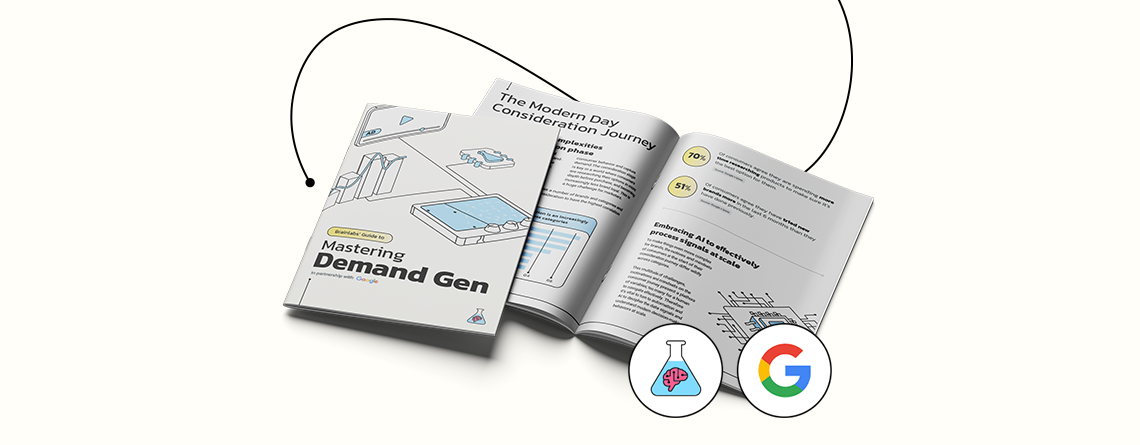Introduction
It’s no secret that marketers today are being asked to do more with less. As we await the death of the cookie, combined with macroeconomic factors, marketing budgets are set to continue to come under scrutiny. However today’s AI revolution is changing the way marketers work, giving us the power to stay on top of these seismic shifts.
Launched in September 2023, Demand Gen, Google’s AI-powered tool was built to help advertisers convert consumers with immersive, relevant, and visual creatives that grab attention and spur action in the right moment. In true Brainlabs fashion, we tested its ability to decode a myriad of consumer signals and better understand the behaviors of modern consumer decision making. The result?
A 35% uplift across all objectives and an augmented approach to performance at scale.
Published in partnership with Google, we’ve put together our guide to help advertisers get the most out of this powerful tool.
Contents
- The Modern Day Consideration Journey
- Beyond the Discovery Moment
- Assessing the Impact of Demand Gen
- Reviewing our Findings
- The Winning Formula for Demand Gen
- In Summary
The Modern Day Consideration Journey
We’ve conducted Correlation Analysis across a number of brands and categories and results from our analysis showed brand consideration to have the highest correlation with purchase intent.
As media has transitioned into a digital realm, the traditional divide between ‘brand-building’ and ‘performance’ overlooks the complexities of today’s shopping journey.
The ‘messy middle’, often overlooked, offers a unique opportunity to utilize data signals in real-time to predict consumer behavior and capture demand.The consideration stage is key in a world where consumers are researching their options in more depth before purchase, and becoming increasingly less brand loyal. This is a huge challenge for marketers.
Navigating the complexities of the consideration phase
Brand consideration is an increasingly critical lever across categories
Consideration Quality Recommendation Impression Reputation Satisfaction Value
0.0 0.2 0.4 0.6
Source: Brainlabs Correlation Analysis
To make things even more complex for brands, the motives and mindsets of consumers at the start of their consideration journey differ wildly across categories.
This multitude of challenges, motivations and mindsets on the consumer journey present a plethora of variables; too many for a human to navigate effectively. Therefore it’s vital to turn to automation and AI to decipher the data signals and understand modern decision-making behaviors at scale.
Embracing AI to effectively process signals at scale
70 % Of consumers agree they are spending more time researching products to make sure it’s the best option for them.
51 % Of consumers agree they have tried new brands more in the last 6 months than they have done previously.
Source: Google x Ipsos
Source: Google x Ipsos
+ 40 % Increase (vs 2020) in consumers’ typical method of brand discovery being in social environments.
15-34 % Of people would have clicked on their second choice brand (with an identical proposition) just by showing up in the right moment.
Source: GWI
Source: Google
Beyond the Discovery Moment
Video has revolutionized shopping and searching, with more users defaulting to video environments for inspiration and seeking out solutions. The surge in content like product reviews, tutorials, or unboxings by trusted voices means that users are increasingly starting their journeys in video environments, and as advertisers we must capitalize on these or risk missing out on winning that initial discovery moment. In 2023, our most notable discoveries and successes revolved around the impact of video views during crucial trigger moments that initiate the consideration journey. Simply showing up in these moments can yield substantial gains for advertisers.
The landscape is changing, but winning the discovery moment is still key
Demand Gen is a new ad solution that helps advertisers find and convert consumers with immersive, relevant and visual creatives that grab attention and spur action in the right moment. Running across YouTube, Shorts, Discover, and Gmail, Demand Gen serves tailored, audience-first creatives via Google AI to your target audiences.
By integrating these elements into a single bidding algorithm, Demand Gen enables advertisers to consolidate a vast array of consideration journey variables. From this, the algorithm analyzes thousands of signals, identifies patterns and behaviors, and ultimately facilitates the identification of the right users in the right environments.
This streamlined approach enhances communication and fosters efficient progression through consideration journeys aligned with our products, brands, and objectives.
Once interest is sparked, much of the consumer journey currently unfolds beyond our advertisers’ owned platforms. Advertisers should navigate these external environments and guide users to continue their consideration journey in their owned environments. Demand Gen presents an opportunity not only to establish a presence in these exploration spaces but also to actively guide users through their consideration journey towards desired outcomes for our brands.
So how do you drive action with Demand Gen?
Demand Gen Creative Optimization Exploration Environments Consideration Objectives
Assessing the Impact of Demand Gen
What did we test?
199 Campaigns globally
£1.5M Media Spend
24 Key tests featured in review
Reviewing our findings
To ensure comprehensive learning during Demand Gen testing, we conducted tests across multiple brands and territories, while also gathering relevant data points for performance measurement.
We consolidated the findings from our 24 key tests and observed a 35% increase across all objectives–proving definitively that Demand Gen is a strong driver of mid-funnel actions beyond the initial trigger moment.
While not all 199 campaigns could be structured into formal experiments, they provided valuable performance insights into the Demand Gen campaign variables we can experiment with to optimize performance for our brands.
The performance review features 24 key tests (utilizing client targets and comparable activity across channels, as well as supplementary lift studies in cases), and are designed to evaluate Demand Gen’s effectiveness, role in the funnel, and impact on our marketing mix.
35 % Median uplift across all objectives vs campaign target / comparable activity
We then categorized their conversion objectives to mirror user actions throughout the journey, with the aim of gauging the extent to which Demand Gen was guiding users through their consideration process.
Our results clearly indicate that Demand Gen delivers significant uplift across all the objectives we tested throughout the customer journey. However, it is by far the most effective at moving users through the exploration phase with page views.
KPI Uplift vs Objective Type
Recognizing that Demand Gen offers advertisers the flexibility to optimize for various objectives, we’ve made sure that the results in our key tests are drawn from campaigns where the bidding algorithm was tailored to optimize for those specific goals.
So, for example, in the illustration below, all page view results were derived from campaigns optimized for page views, and the same approach was taken for on-site actions, basket actions, and purchases. This enables us to focus on how effectively Demand Gen drives the goals and objectives that are most important to our clients. And outside of the significant uplift, we supported our research with a number of lift studies to deepen our understanding of the impact on the consumer journey and relationship within our marketing mix.
By engaging users during the discovery phase and leveraging Demand Gen to present tailored solutions, we observed not only a significant increase in the volume of users beginning their exploration journey with our brands, but also an improvement in the quality of page interactions.
Our testing has proven that Demand Gen is effective at:
- Shortening the exploration journey
- Moving users deeper through the consideration journey
- Reducing the friction between intent and action
Page view On-site action Basket action Purchase
+ 20 % On-Site Action
+ 11 % Basket Action
Demand Gen’s combination of key exploration environments, creative and placement variation, and range of performance objectives, make up the perfect combination of variables from which to decode, decipher and optimize towards our key consideration signals, ultimately maximizing results.
For advertisers that want to play in this space to grow their headroom, leveraging the bidding algorithm of Demand Gen to target actions deeper along the consideration journey is extremely powerful.
We have seen significant uplift in Demand Gen driving users even further through their consideration journey, from on-site actions to basket actions. Most intriguing is the significant spike in driving actual sales–especially for a tool primarily built for driving mid-funnel engagement.
Studies show there’s a rising trend in impulse decision-making during the consideration journey. Therefore, by reducing the friction between intent and action through Demand Gen’s action-focused placements and optimization, advertisers can capitalize on this shift in purchase behavior to win for their brands.
This suggests that by capturing attention during the discovery moments rather than waiting for explicit interest, Demand Gen can drive users to continue their exploration onsite, rather than in a more neutral environment, and shorten the exploration journey.
+ 78 % Page View
+38% Search Lift
+ 26 % Purchase
+48% Assisted Conversions
The Winning Formula for Demand Gen
Read on for the four key focus areas where we believe advertisers can optimize Demand Gen and where teams can augment Google’s decision-making engine to drive significant campaign gains.
Creative
While leveraging Google AI’s decision-making power was a major appeal of testing Demand Gen, our extensive testing in automation outlines the additional value that the right human involvement in setting up your campaigns can deliver.
Creative content is one of the most important variables that we can control to help boost campaign performance, yet current capabilities within Demand Gen do not include the ability to fully comprehend the context of our creative content.
However, as part of our creative analysis in our study, we found that lifestyle images significantly outperformed other types in terms of engagement rate. This aligns with the early exploration phase, where users are more focused on identifying solutions for their needs rather than specific products.
As users progress through the funnel, hybrid creative of lifestyle images with a text overlay prove most effective in driving on-site actions, recording a 40% uplift in conversion rates compared to the next best creative.
Leveraging both lifestyle settings and text overlays presents a compelling opportunity to communicate value propositions effectively in Demand Gen’s exploration placements.
While Demand Gen’s algorithm currently lacks the ability to identify the context of images, such as recognizing the effectiveness of lifestyle creatives, it excels in learning and optimizing toward the best-performing individual assets. We’ve observed that image ads are most effective at driving initial exploration, especially in campaigns optimized for page views, a goal typically associated with earlier stages of the consideration journey. We also found that the more image variations you provide your campaign with, the better the campaign will perform.
We’ve identified four key focus areas where we believe advertisers can optimize Demand Gen and where teams can augment Google’s decision-making engine to drive significant campaign gains.
In addition to assessing whether Demand Gen delivers against our objectives and its role in the funnel and marketing mix, our goal was to uncover strategies for maximizing campaign success, through the insights gleaned from our analysis of all 199 campaigns.
Our recommendations
- Image variations: Give the AI all the assets: Experiment and learn what works for your objectives
- Be native to the consideration journey: Frame products in a lifestyle setting
- Tailor your messaging: Tap into the myriad of consumer motivations with creative variations
Shop now Sign up Book now Learn more Book your flight today Hybrid (Lifestyle & Text) Text Lifestyle Product
Placements
Demand Gen provides a range of placements, each catering to different exploration environments, with varying creative requirements, costs, and functions. Our testing has emphasized the importance of a balanced placement mix for achieving campaign objectives effectively. Advertisers aiming to maximize campaign impact should provide the necessary assets to support this mix.
While Shorts and Skippable Video placements are pricier, they have been shown to significantly inspire deeper consideration actions, with campaigns featuring a healthy mix of video (25%+ delivery across video assets) yielding up to 10 times higher conversion rates.
We’ve observed that different placements exhibit strengths and weaknesses depending on the campaign goal and desired actions throughout the purchase consideration journey. Although a balanced mix of video vs non-video placements delivered the strongest aggregate results across all advertisers and conversion types, we can see that the more we are asking the user to do, the more effective video is. This underscores the complexity of the consideration journey, highlighting the importance of longer-form video in driving user preference, while simpler image ads are enough to spark initial interest and prompt further exploration.
Our recommendations
- Maximize video assets: Give yourself the best chance of diving deeper down the journey
Bidding
To ensure optimal performance in the mid-funnel, particularly with video placements, it’s crucial to provide sufficient campaign budget. A higher budget allows the algorithm to explore video environments more extensively, and learn from video interactions to drive meaningful performance uplifts, rather than limiting its initial learning to the cheaper placements that are less effective at driving users deeper through the journey. Our testing revealed significant increases in conversion rates (CvR) with higher budget levels, indicating the importance of budget allocation for accessing inventory that drives results.
Additionally, selecting the right bidding strategy is essential for achieving target outcomes. The variety of bidding solutions offered by Demand Gen address mid-funnel challenges and allow us to tailor the algorithm to key exploration, evaluation, and intent mindsets. For site action beyond a page view, conversion-based bid optimization is essential, as it prevents the algorithm from fixating on click-focused inventory, ultimately preserving the bottom line.
Our recommendations
- Healthy budgets facilitate better learning: Don’t limit the algorithm to learning in the cheapest environments
- Effectiveness > Volume: Better and faster learning against the objectives you care about the most
Audience
2024 is set to be a crucial year for audience targeting. With addressability of cookie-based segments increasingly in doubt and the rise of AI-based buying methods, it bodes the question on whether audience precision is still a source of effectiveness or rather a hindrance.
Owned data remains fundamental for purchase-optimized campaigns. Retargeting audiences demonstrated a notable 3x improvement in cost per acquisition (CPA) through heightened precision compared to off-the-shelf segments. This highlights the potential of Demand Gen placements in fostering purchase intent and product consideration amongst these key audiences.
Additionally, our findings reveal surprising results in optimized targeting. In our page-view optimized campaigns we saw a 25x CPPV (Cost per page view) reduction for users not included in any segment vs off-the-shelf lists. An optimization goal earlier in the consideration journey gives the algorithm more freedom to find high conversion rates at improved cost efficiencies – and given the room to breathe, the algorithm can seemingly do this more effectively than pre-segmented third-party audiences. While AI-based targeting isn’t novel, amidst uncertainty surrounding the longevity of effective third-party audience segments, solutions like optimized targeting and complementary off-the-shelf campaigns are likely here to stay.
Our recommendations
- Let the algorithm find your headroom: Broader audience targeting allows the algorithm to identify prospects in the discovery phase through more complex and nuanced behavioral signals
- First party data is still king: Retargeting still works, especially when driving lower-funnel objectives
3 x Improvement in cost per acquisition (CPA) from retargeting audiences compared to the off-the-shelf segments
25 x Improvement in CPVV when targeting broader audiences for earlier journey conversion objectives
Actions to get the best out of your Demand Gen campaigns
- Ensure there is clear alignment on the campaign goals/KPIs to measure success, ramp time, and budget.
- Have a consolidated campaign structure for effective learning–consolidate ad groups by combining similar audience themes whenever possible, and consider merging ad groups with fewer than ~30 conversions in 30 days.
- Limit bid changes to +/- 5% to avoid performance volatility.
- Avoid making drastic changes to the set up during the testing period.
- Build a robust testing framework that takes into account your campaign objectives.
Testing Framework
Learning Period Launch Demand Gen Campaign Lag Time Performance Evaluation Scale Campaign Period with Optimization
2 Weeks Min 4-6 Weeks Recommended Budget Dependent
In Summary
The value of Demand Gen in deciphering the intricate signals and nuances of the mid-funnel consideration journey is clear, leaving us certain that AI-driven solutions are the future of digital advertising. When coupled with expert human insight, we achieve an augmented approach to generating demand, whilst effectively navigating the complexities of the consideration journey.
As AI continues to play a pivotal role across all stages of the funnel, the fusion of AI and expert human understanding emerges as the gold standard for advertisers and agencies alike. This combination presents an enhanced approach to performance at scale, surpassing what either can achieve in isolation.
So embrace AI–the results from our testing tells us we’d be foolish not to–but remember these advancements are not a replacement for human-driven innovative strategy, rather tools to help you bring your strategy to life.
Insights provided by:
Alex Glover Programmatic Product Partner, UK
Joe Spicer Account Director, UK
Get in touch
If you’d like to speak to one of our experts, please contact us at: partnerships@brainlabsdigital.com



